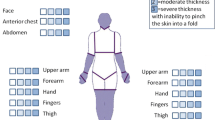Abstract
Scleroderma is an uncommon condition, but has features that are commonly encountered in a general population such as Raynaud’s phenomenon and gastroesophageal reflux. Therefore, having an appropriate level of suspicion for the diagnosis will help facilitate getting them to the appropriate specialist. However, there are other patients who present with features considered to be typical of scleroderma, such as Raynaud’s and skin thickening, who may have a syndrome mimicking scleroderma. So familiarity with these mimickers is critical for rheumatologists of other physicians who evaluate patients with scleroderma. Raynaud’s phenomenon and digital ischemia can be associated with multiple different etiologies, rheumatic and non-rheumatic and should be considered even in scleroderma patients with atypical findings (i.e., isolated toe ischemia).
Similar content being viewed by others
References
Gelber AC, Wigley FM, Stallings RY, et al. Symptoms of Raynaud’s phenomenon in an inner-city African-American community: prevalence and self-reported cardiovascular comorbidity. J Clin Epidemiol. 1999;52(5):441–6.
Jones GT, Herrick AL, Woodham SE, Baildam EM, Macfarlane GJ, Silman AJ. Occurrence of Raynaud’s phenomenon in children ages 12–15 years: prevalence and association with other common symptoms. Arthritis Rheum. 2003;48(12):3518–21.
Voulgari PV, Alamanos Y, Papazisi D, Christou K, Papanikolaou C, Drosos AA. Prevalence of Raynaud’s phenomenon in a healthy Greek population. Ann Rheum Dis. 2000;59(3):206–10.
Maricq HR, Carpentier PH, Weinrich MC, et al. Geographic variation in the prevalence of Raynaud’s phenomenon: a 5 region comparison. J Rheumatol. 1997;24(5):879–89.
Koenig M, Joyal F, Fritzler MJ, et al. Autoantibodies and microvascular damage are independent predictive factors for the progression of Raynaud’s phenomenon to systemic sclerosis: a twenty-year prospective study of 586 patients, with validation of proposed criteria for early systemic sclerosis. Arthritis Rheum. 2008;58(12):3902–12.
Liu A, Zhang W, Tian X, Zhang X, Zhang F, Zeng X. Prevalence, risk factors and outcome of digital gangrene in 2684 lupus patients. Lupus. 2009;18(12):1112–8.
Kalluri M, Sahn SA, Oddis CV, et al. Clinical profile of anti-PL-12 autoantibody. Cohort study and review of the literature. Chest. 2009;135(6):1550–6.
Glendenning JL, Barbachano Y, Norman AR, Dearnaley DP, Horwich A, Huddart RA. Long-term neurologic and peripheral vascular toxicity after chemotherapy treatment of testicular cancer. Cancer. 2010;116(10):2322–31.
Maricq HR, Johnson MN, Whetstone CL, LeRoy EC. Capillary abnormalities in polyvinyl chloride production workers. Examination by in vivo microscopy. Jama. 1976;236(12):1368–71.
Rustin MH, Bull HA, Ziegler V, et al. Silica-associated systemic sclerosis is clinically, serologically and immunologically indistinguishable from idiopathic systemic sclerosis. Br J Dermatol. 1990;123(6):725–34.
Belongia EA, Hedberg CW, Gleich GJ, et al. An investigation of the cause of the eosinophilia-myalgia syndrome associated with tryptophan use. N Engl J Med. 1990;323(6):357–65.
Kaufman LD, Krupp LB. Eosinophilia-myalgia syndrome, toxic-oil syndrome, and diffuse fasciitis with eosinophilia. Curr Opin Rheumatol. 1995;7(6):560–7.
Kilbourne EM, Posada de la Paz M, Abaitua Borda I, Diez Ruiz-Navarro M, Philen RM, Falk H. Toxic oil syndrome: a current clinical and epidemiologic summary, including comparisons with the eosinophilia-myalgia syndrome. J Am Coll Cardiol. 1991;18(3):711–7.
Fonseca E, Contreras F. Cutaneous mucinosis in the toxic oil syndrome. J Am Acad Dermatol. 1987;16(1 Pt 1):139–40.
Cowper SE, Robin HS, Steinberg SM, Su LD, Gupta S, LeBoit PE. Scleromyxoedema-like cutaneous diseases in renal-dialysis patients. Lancet. 2000;356(9234):1000–1.
Cole GW, Headley J, Skowsky R. Scleredema diabeticorum: a common and distinct cutaneous manifestation of diabetes mellitus. Diabetes Care. 1983;6(2):189–92.
Wright RA, Bernie H. Scleredema adultorum of Buschke with upper esophageal involvement. Am J Gastroenterol. 1982;77(1):9–11.
Dinneen AM, Dicken CH. Scleromyxedema. J Am Acad Dermatol. 1995;33(1):37–43.
Blum M, Wigley FM, Hummers LK. Scleromyxedema: a case series highlighting long-term outcomes of treatment with intravenous immunoglobulin (IVIG). Medicine (Baltimore). 2008;87(1):10–20.
Berger JR, Dobbs MR, Terhune MH, Maragos WF. The neurologic complications of scleromyxedema. Medicine (Baltimore). 2001;80(5):313–9.
Webster GF, Matsuoka LY, Burchmore D. The association of potentially lethal neurologic syndromes with scleromyxedema (papular mucinosis). J Am Acad Dermatol. 1993;28(1):105–8.
Godby A, Bergstresser PR, Chaker B, Pandya AG. Fatal scleromyxedema: report of a case and review of the literature. J Am Acad Dermatol. 1998;38(2 Pt 2):289–94.
Shulman LE. Diffuse fasciitis with eosinophilia: a new syndrome? Trans Assoc Am Physicians. 1975;88:70–86.
Lakhanpal S, Ginsburg WW, Michet CJ, Doyle JA, Moore SB. Eosinophilic fasciitis: clinical spectrum and therapeutic response in 52 cases. Semin Arthritis Rheum. 1988;17(4):221–31.
Author information
Authors and Affiliations
Corresponding author
Editor information
Editors and Affiliations
Rights and permissions
Copyright information
© 2012 Springer Science+Business Media, LLC
About this chapter
Cite this chapter
Hummers, L.K. (2012). Scleroderma Mimics. In: Varga, J., Denton, C., Wigley, F. (eds) Scleroderma. Springer, Boston, MA. https://doi.org/10.1007/978-1-4419-5774-0_11
Download citation
DOI: https://doi.org/10.1007/978-1-4419-5774-0_11
Published:
Publisher Name: Springer, Boston, MA
Print ISBN: 978-1-4419-5773-3
Online ISBN: 978-1-4419-5774-0
eBook Packages: MedicineMedicine (R0)




